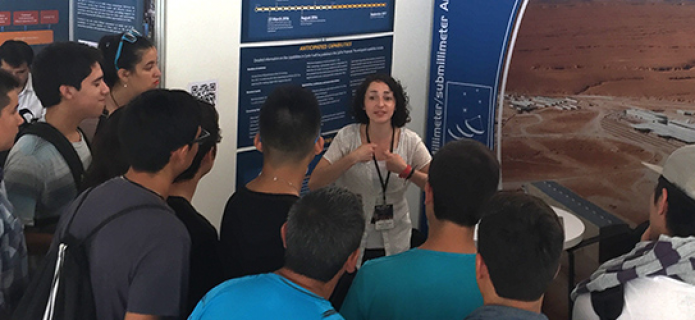Overwhelming public participation in ALMA activitie
Interest around the ALMA observatory and astronomy in general was once again confirmed last season with the participation of close to 55 thousand people in outreach activities between October 2015 and April 2016. The major event was the “ALMA, in search of our cosmic origins” exhibit, held in Espacio Fundación Telefónica, attracting over 35 thousand visitors in downtown Santiago, Chile. Other activities included the traditional “Nights of Stars in the Metropolitan Park,” the participation of ALMA in the SonarSound festival, the Open House during Astronomy Day in Chile and many more.
Professional astronomers guided more than 2000 visitors who attended the exhibit in Fundación Telefónica during its last weekend. This was the first mass exhibit for ALMA, and included round tables, astronomic observations from the heliport and astrophotography workshops, just to name a few of the activities.
Credit: ALMA (ESO/NAOJ/NRAO)
The traditional Nights of Stars in the Metropolitan Park once again drew a crowd of around one thousand people last December and January. In a family-friendly environment, the young and old learned about the wonders of the Universe with astronomers José Gallardo and Antonio Hales, and then were able to observe the stars directly through telescopes under the care of Astroblog and ALMA.
Credit: ALMA (ESO/NAOJ/NRAO)
ALMA participated in an activity completely outside the bounds of its traditional scientific mission in early December. The project ALMA Sounds was launched in the first version of the SonarSound festival that reached Chile from Barcelona. Close to 14 thousand fans of electronic music learned about this project, which created musical bytes from electromagnetic observations with ALMA. This resulted in a public library of sounds available on the ALMA Sounds website, which can be freely used by artists in their musical compositions and then shared on the same site.
The music you are listening to is made with sounds from space. In the middle of the Atacama Desert you can find ALMA, the largest astronomical center in the world: 66 antennas at 5,000 meters above sea level. The ALMA Sounds project, motivated by the Sonar festival transforms electromagnetic frequencies captured in space into audible waves. In other words, it converts the light from stars into sound. These sounds can be downloaded for free and used by creators around the world. They say that there is no sound in space but if we join art and science, we can imagine it. | Credit: PlayGround.
ALMA also closed out 2015 with music, but in this case played by children from neighboring communities near the observatory. Approximately 50 students, members of school orchestras from San Pedro de Atacama and Toconao played a repertoire of classical music and Christmas carols to ALMA staff in the Operations Support Facility (OSF) located 2,900 meters above sea level.
Credit: ALMA (ESO/NAOJ/NRAO)
And to close out the summer holidays in the southern hemisphere, the Chilean Astronomy Society held its 13th annual meeting in Antofagasta. ALMA had a stand at the event, with information about the capacities available for Cycle 4 observations, and astronomer Antonio Hales motivated participants to send their observation proposals to use this incredible tool.
Credit: ALMA (ESO/NAOJ/NRAO)
To celebrate Astronomy day in Chile, ALMA and ESO came together to hold a new open house for schoolchildren and the general public to participate in diverse activities such as a mobile planetarium, observation of the Sun, rocket construction and workshops held with astronomers Lizette Guzmán and Baltasar Vila.
Credit: ALMA (ESO/NAOJ/NRAO)
Finally, in early April, ALMA participated in the Antofagasta - Port of Ideas Festival for dissemination of science and culture. ALMA specifically participated in the activity “Trip to the Stars,” where participants were able to observe the Universe with telescopes in the middle of the Atacama Desert. The activity was led by ALMA astronomers and the other participating institutions and was the first festival activity to sell out.
Credit: ALMA (ESO/NAOJ/NRAO)
Additional information
ALMA is a partnership of ESO (representing its member states), NSF (USA) and NINS (Japan), together with NRC (Canada), NSC and ASIAA (Taiwan), and KASI (Republic of South Korea), in cooperation with the Republic of Chile. The Joint ALMA Observatory is operated by ESO, AUI/NRAO and NAOJ.
Contacts
-
Nicolás Lira
Education and Public Outreach OfficerJoint ALMA Observatory, Santiago - ChilePhone: +56 2 2467 6519Cel: +56 9 9445 7726Email: [email protected] -
Charles E. Blue
Public Information OfficerNational Radio Astronomy Observatory Charlottesville, Virginia - USAPhone: +1 434 296 0314Cel: +1 202 236 6324Email: [email protected] -
Masaaki Hiramatsu
Education and Public Outreach Officer, NAOJ Chile -
Richard Hook
Public Information Officer, ESOGarching bei München, GermanyPhone: +49 89 3200 6655Cel: +49 151 1537 3591Email: [email protected]
